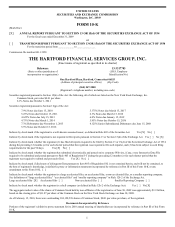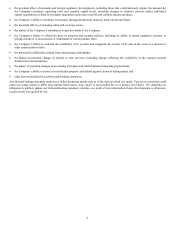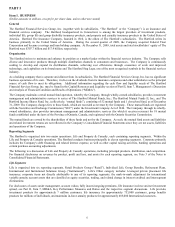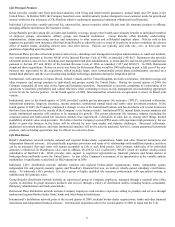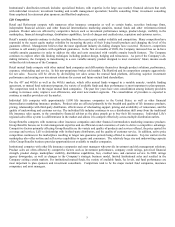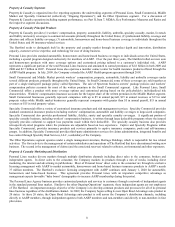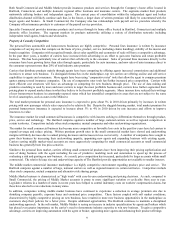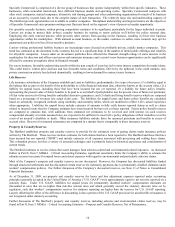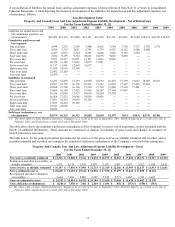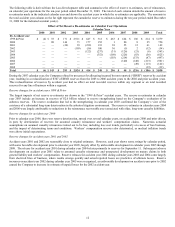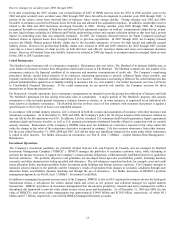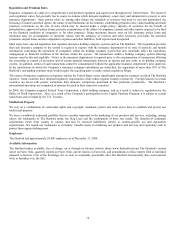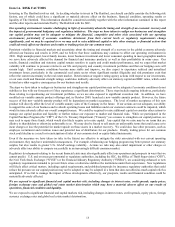The Hartford 2009 Annual Report Download - page 5
Download and view the complete annual report
Please find page 5 of the 2009 The Hartford annual report below. You can navigate through the pages in the report by either clicking on the pages listed below, or by using the keyword search tool below to find specific information within the annual report. 5
PART I
Item 1. BUSINESS
(Dollar amounts in millions, except for per share data, unless otherwise stated)
General
The Hartford Financial Services Group, Inc. (together with its subsidiaries, “The Hartford” or the “Company”) is an insurance and
financial services company. The Hartford, headquartered in Connecticut, is among the largest providers of investment products,
individual life, group life and group disability insurance products, and property and casualty insurance products in the United States of
America. Hartford Fire Insurance Company, founded in 1810, is the oldest of The Hartford’ s subsidiaries. The Hartford writes its
business primarily in the United States of America. During the second quarter of 2009, the Company acquired Federal Trust
Corporation and became a savings and loan holding company. At December 31, 2009, total assets and total stockholders’ equity of The
Hartford were $307.7 billion and $17.9 billion, respectively.
Organization
The Hartford strives to maintain and enhance its position as a market leader within the financial services industry. The Company sells
diverse and innovative products through multiple distribution channels to consumers and businesses. The Company is continuously
seeking to develop and expand its distribution channels, achieving cost efficiencies through economies of scale and improved
technology, and capitalizes on its brand name and The Hartford Stag Logo, one of the most recognized symbols in the financial services
industry.
As a holding company that is separate and distinct from its subsidiaries, The Hartford Financial Services Group, Inc. has no significant
business operations of its own. Therefore, it relies on the dividends from its insurance companies and other subsidiaries as the principal
source of cash flow to meet its obligations. Additional information regarding the cash flow and liquidity needs of The Hartford
Financial Services Group, Inc. may be found in the Capital Resources and Liquidity section of Part II, Item 7, Management’ s Discussion
and Analysis of Financial Condition and Results of Operations (“MD&A”).
The Company maintains a retail mutual fund operation, whereby the Company, through wholly-owned subsidiaries, provides investment
management and administrative services to series of The Hartford Mutual Funds, Inc.; The Hartford Mutual Funds II, Inc.; and The
Hartford Income Shares Fund, Inc. (collectively, “mutual funds”), consisting of 52 mutual funds and 1 closed-end fund, as of December
31, 2009. The Company charges fees to these funds, which are recorded as revenue by the Company. These mutual funds are registered
with the Securities and Exchange Commission (“SEC”) under the Investment Company Act of 1940. The Company, through its wholly-
owned subsidiaries, also provides investment management and administrative services (for which it receives revenue) for 18 mutual
funds established under the laws of the Province of Ontario, Canada, and registered with the Ontario Securities Commission.
The mutual funds are owned by the shareholders of those funds and not by the Company. As such, the mutual fund assets and liabilities
and related investment returns are not reflected in the Company’ s Consolidated Financial Statements since they are not assets, liabilities
and operations of the Company.
Reporting Segments
The Hartford is organized into two major operations: Life and Property & Casualty, each containing reporting segments. Within the
Life and Property & Casualty operations, The Hartford conducts business principally in eleven reporting segments. Corporate primarily
includes the Company’ s debt financing and related interest expense, as well as other capital raising activities, banking operations and
certain purchase accounting adjustments.
The following is a discussion of Life and Property & Casualty operations, including principal products, distribution, and competition.
For financial disclosures on revenues by product, profit and loss, and assets for each reporting segment, see Note 3 of the Notes to
Consolidated Financial Statements.
Life Segments
Life is organized into six reporting segments, Retail Products Group (“Retail”), Individual Life, Group Benefits, Retirement Plans,
International and Institutional Solutions Group (“Institutional”). Life’ s Other category includes: leveraged private placement life
insurance; corporate items not directly attributable to any of its reporting segments; the mark-to-mark adjustment for international
variable annuity account assets that are classified as equity securities, trading, and related change in interest credited; and intersegment
eliminations.
For disclosures of assets under management, account values, fully insured ongoing premiums, life insurance in-force and net investment
spread, see Part II, Item 7, MD&A, Key Performance Measures and Ratios and the respective segment discussions. Life provides
investment products for approximately 7 million customers; life insurance for approximately 753,000 customers, group benefits
products for millions of individuals, and maintains in-force annuity products for approximately 485,000 International customers.

